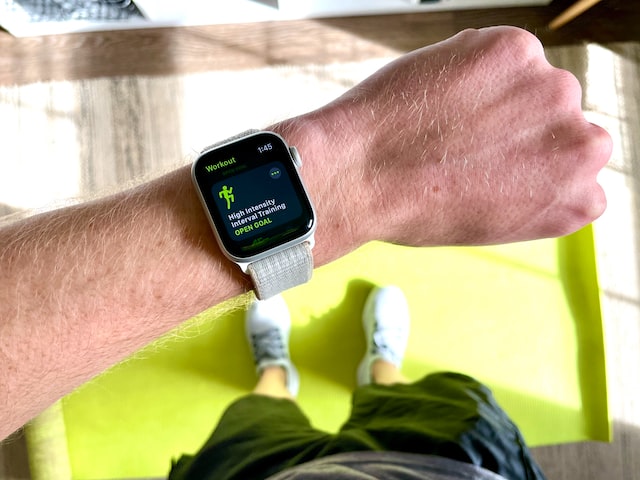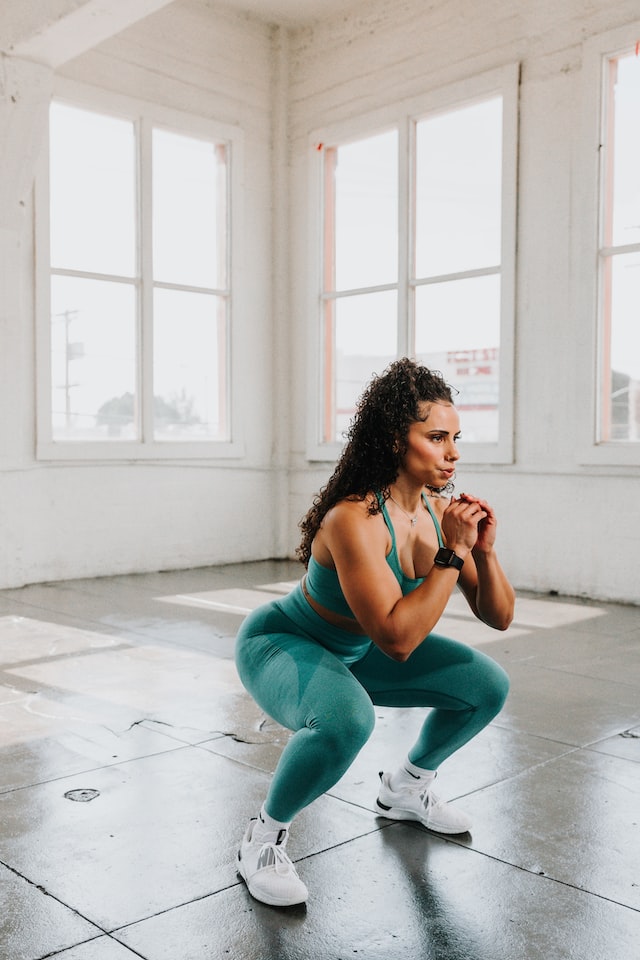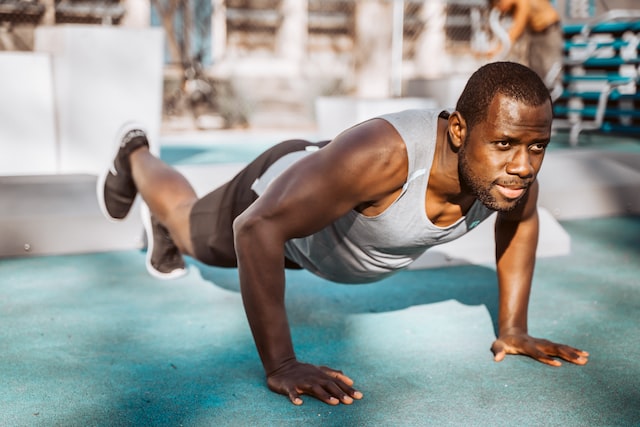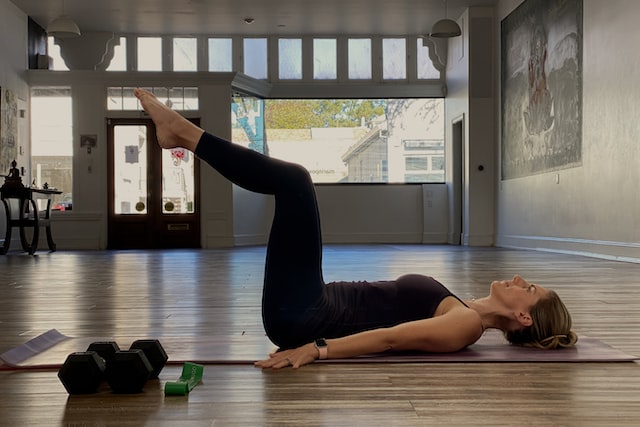Strength training, regardless of age or athletic skill, is the key to better flexibility, mobility, performance, and injury prevention. Strength training is something that everybody, regardless of fitness level, can and should do. And seeing results doesn’t have to take hours at the gym. In the comfort of your own home, we’ll teach you the fundamentals of strength training. A full-body strength-building workout will take only nine minutes of effort. Grab a towel and prepare to feel powerful.

Strength Training in 9 Minutes
The nine moves listed below are strength training routines that you may have seen previously. They work a specific group of muscles when performed alone, but when performed in one-minute intervals, these nine exercises form a full-body workout.
We divided the nine exercises into three sets of three. Set a timer before starting each set. If you’re just starting out, execute each exercise at full intensity for one minute, then move on to the next, until you’ve finished the first set. Then, take a one-minute pause before proceeding to set 2, where the exercises should be completed for one minute each. You’ll eventually finish the program, having done nine minutes of training with two minutes of total rest in between.
For best results, repeat this workout two to three times per week.
Are you willing to give it a shot? Lace up those trainers and let’s crack in!
Set 1: bodyweight squats, push-ups, and mountain climbers
Perform each of the movements in this set for one minute, without resting in between.
Squat Using Only Your Body Weight
Every time you sit or stand, you squat, but don’t take this workout for granted. It targets your legs and glutes, the body’s most powerful muscular group.

Take care: Squats can be painful on your knees if done incorrectly. Keep your buttocks pushed out when you squat, as if you were ready to sit on a chair. Push yourself up using the muscles in your hips and thighs; don’t move by pressing your knees forward. If you perform it correctly, your knees will only move during the first half of the squat; your hips will complete the movement.
Set a goal for yourself: Jump from the lowest position back into your starting posture to add some plyometric action to your squat.
Bodyweight Squat Technique
An essential workout for strengthening your legs and glutes.
- Stand with your hands behind your head and your feet shoulder-width apart, slightly turned out to open the hip joint.
- Squat down until your thighs are parallel to the floor.
- Take a breather, then return to your starting position.
- Repeat.
Increase the difficulty by springing up explosively from each squat, being sure your feet to lift off the floor.
Push-Up
Push-ups are a popular bodybuilding workout for a reason. They train the muscles in your shoulders and chest effectively.
If normal push-ups are too difficult, try them with your knees on the floor. This reduces the amount of weight you must lift.
Set a goal for yourself: To boost the difficulty of basic push-ups, place your feet on a step or block.
How to Perform a Push-Up
This fundamental exercise will help you develop the muscles in your shoulders and chest.
- Get down on all fours, hands slightly wider than your shoulders.
- Extend your arms and legs.
- Lower your body until your chest is almost touching the ground.
- Take a breather, then push yourself back up.
- Repeat.
Mountain Climbers
This workout resembles the motion of climbers as they ascend steep peaks, but it is performed on the even surface of your floor. Mountain climbers are total-body workouts that strengthen your core, back, arms, and legs, as well as your heart.
If this exercise causes too much pressure on your wrists, raise your upper body by placing your hands on a step to minimize the weight on your arms.
Mountain Climbers’ Techniques
This simple exercise will work your entire body.
- Get down on your hands and knees on the floor.
- Extend your left leg behind you and place your right knee near your right hand.
- Switch your legs in one fluid motion while keeping your arms in the same posture.
- Switch your legs back and forth, bringing your right leg back up to your right hand.
Set 2: plank, a bodyweight split squat, and a single-leg hip raise
After the first set of exercises, take a one-minute pause. Set two is now ready for you.

Plank
The plank is a common exercise that helps strengthen the core, shoulders, arms, and legs. Planking strengthens your upper body and tones your abs. This exercise also strengthens both the abdominal and low back muscles at the same time, which might be good for persons suffering from low back discomfort.
Planking can be challenging on your wrists, which is why we recommend doing it on your forearm.
Change it: Plank with your knees on the floor to lessen the amount of weight on your forearms.
What Is a Forearm Plank?
Build core and upper body strength without moving a muscle – sort of.
- Begin in a push-up stance, but bend your arms at the elbows so your weight is supported by your forearms.
- Tighten your core, squeeze your glutes, and maintain a straight body from head to heels.
- Maintain your grip for as long as possible.
Split Squat Using Your Body Weight
This squat variation focuses on the quadriceps and hamstrings in your legs, as well as the glutes. Jumping into your starting posture from the bottom of your squat offers a plyometric boost as well.
If balance is a difficulty, do this exercise near to a wall and rest your hand on it for support.
Change it: If you find the plyometric jump too taxing on your knees, leave it out.
Set a goal for yourself: Jump higher to get your heart rate up and your strength up.
Split Squat Technique
This workout will help you build muscle in your upper legs.
- Put your hands on your hips and take a staggered stride forward with your left leg.
- Lower your body as slowly as you can.
- When you’ve gotten as low as you can, jump with enough force to lift both feet off the ground.
- Step forward with your right leg.
- Alternate back and forth for the duration of the time allocated.
- Once you’ve mastered this maneuver, you can swing your arms in the opposite direction of your legs, as if you were running.
Single Leg Hip Raises
This yoga-inspired exercise targets the muscles in your glutes and abs.
Take care: As you perform this exercise, keep your foot firmly planted on the floor.
Set a goal for yourself: As you perform this exercise, place your steady foot on a step or bench to allow you to elevate your hips even higher.
How to Perform a Single-Leg Hip Raise
Increase your hip, glute, and ab strength.
- Lie on your back, right knee bent, right foot flat on the floor.
- Raise your left leg such that it is parallel to your right thigh.
- Raise your hips, keeping your left leg up.
- Take a breather and slowly return to your starting posture.
- Change legs and repeat.
Set 3: burpee with a push-up, single-leg toe touches, and leg raises
Excellent news! You’re almost finished. After the second set, take a one-minute pause. Then begin the third set, performing each exercise for one minute.

Burpees with Push-Ups
This entire body exercise will get your heart beating quickly, but don’t trade form for speed. It’s fun to say, but it’s also good for your body. Maintain control of your body as you perform the activity.
Don’t go too fast. Pace your breathing and yourself. Take a deep breath in before squatting and a deep breath out during the push-up.
Change it: Make adjustments to the legs to make this more challenging. Leg modifications include moving the right leg to a 3 o’clock position and then back to center, bringing the left leg to a 9 o’clock position and then back to center, and then performing a push-up. This is known as the 3 o’clock 9 o’clock burpee.
Set a goal for yourself: Stretch your legs back before your hands contact the ground to go faster through your burpees. Also, to allow your legs full range of motion, don’t arch your back while you move.
How to Perform a Burpee with a Push-Up
This is a full-body, heart-pounding workout.
- Place your feet shoulder width apart.
- Squat as low as possible and place your hands on the floor. Return to a push-up position.
- Perform one push-up.
- Return to a squat and jump up, tossing your hands above your head.
- Land and then repeat.
Single Leg Toe Touch
This workout is excellent for toning your lower body. It improves balance while also working on your hamstrings.
If you have balance concerns, conduct this exercise near a wall that you can lean against for assistance if necessary.
Set a goal for yourself: To make it more difficult, when you rise up, put a slight hop in your planted leg. This changes the activity from isokinetic to plyometric and raises the difficulty level.
How to Perform Single Leg Toe Touches
Single leg toe touches will tone your lower body and put your balance to the test.
- Balance yourself on your right leg, with your left leg raised off the floor slightly behind you.
- Extend your arms out to your sides at shoulder height.
- Bend your right knee and squat down to connect your left palm to the toe of your right foot, then return to standing. Attempt to keep your leg in the air behind you at all times.
- Repeat the process with your left leg.
- Repeat.
Leg Raises
Leg raises help you build core strength without getting up from the floor. The legs down exercise is beneficial for lower back discomfort, but it is important to move your legs in a controlled manner during the exercise.

Make sure your lower back is pressed into the floor and your ab muscles engaged as you raise your legs.
This How to Perform Leg Raises
While lying down, strengthen your core.
- Lie down on your back with your legs straight and together.
- Keep your legs straight and raise them to the ceiling until your buttocks are off the floor.
- Lower your legs slowly until they are barely above the floor. Please wait a moment.
- Raise your legs again.
- Repeat.
A Final Thought from DigEnet
The beauty of this simple circuit is that it can be made more or less challenging by simply varying your intensity. In this way, both experienced fitness enthusiasts and beginners can be challenged.
Looking for a way to bring this circuit to the next level? Stay tuned for our companion post that injects an element of cardio into this workout for even better results!
